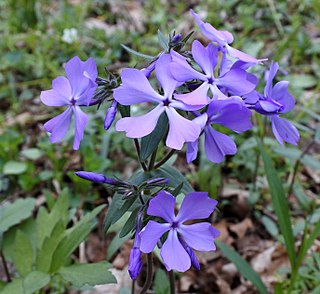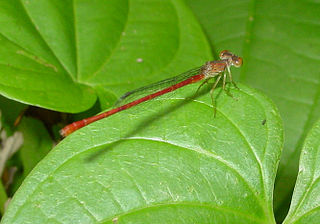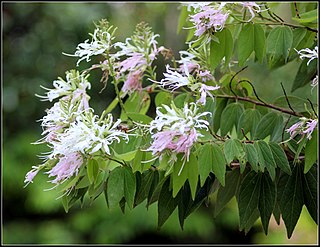
Lake Malawi, also known as Lake Nyasa in Tanzania and Lago Niassa in Mozambique, is an African Great Lake and the southernmost lake in the East African Rift system, located between Malawi, Mozambique and Tanzania.

Phlox divaricata, the wild blue phlox, woodland phlox, or wild sweet william, is a species of flowering plant in the family Polemoniaceae, native to forests and fields in eastern North America.

Lepidochrysops balli, Ball's blue, is a species of butterfly in the family Lycaenidae. It is endemic to South Africa.
Aspatharia is a genus of freshwater mussel, an aquatic bivalve mollusk in the family Iridinidae.
Aspatharia subreniformis is a species of freshwater mussel in the family Iridinidae. It is endemic to Lake Malawi in Malawi.
Pauridiantha divaricata is a species of plant in the family Rubiaceae. It is endemic to Cameroon. Its natural habitat is subtropical or tropical moist lowland forests. It is threatened by habitat loss.

Stegops is an extinct genus of euskelian temnospondyl from the Late Carboniferous of the eastern United States. Fossils are known from the Pennsylvanian coal deposits of Linton, Ohio. It was once classified in the eryopoid family Zatrachydidae because it and other zatrachydids have spikes extending from the margins of its skull, but it is now classified as a dissorophoid that independently evolved spikes. Stegops was first named by American paleontologist Edward Drinker Cope in 1885, with his description of the type species Stegops divaricata. Cope had also named a species of Sauropleura from Linton in 1875, which he called Sauropleura newberryi. This species was later synonymized with Stegops divaricata when the type specimen of S. newberryi was prepared and found to be a large specimen of Stegops.

Telebasis is a genus of damselflies in the family Coenagrionidae. The genus occurs in the Neotropics. Most of the species are red with a few blue species in South America.

Luehea is a genus of trees in the family Malvaceae.

Tabernaemontana divaricata, commonly called pinwheel flower, crape jasmine, East India rosebay, and Nero's crown, is an evergreen shrub or small tree native to South Asia, Southeast Asia and China. In zones where it is not hardy it is grown as a house/glasshouse plant for its attractive flowers and foliage. The stem exudes a milky latex when broken, whence comes the name milk flower

Diastella is a genus containing seven species of flowering plants, commonly known as “silkypuffs”, in the protea family. The name comes from the Greek diastellein “to separate”, with reference to the free perianth lobes – the plants are distinguished from the closely related and similar leucospermums by the possession of four free perianth segments. The genus is endemic to the Cape Floristic Region of South Africa where it has a very limited range and is associated with fynbos habitats. The species are all small shrubs. Most species are threatened.

Bauhinia divaricata, the bull hoof or Mexican orchid tree, is a species of flowering plant in the family Fabaceae. It is native to Mexico, Central America, and the Caribbean.
Acropora hoeksemai is a species of acroporid coral that was first described by Dr. Carden Wallace in 1997. Found in shallow reefs in a marine environment, it is found at depths of 8 to 20 m. It is listed as a vulnerable species on the IUCN Red List, and has a decreasing population. It is common, listed on Appendix II of CITES, and is found over a large range.
Acropora kosurini is a species of acroporid coral that was first described by C. C. Wallace in 1994. Found in marine, shallow reefs, it occurs at depths of 8 to 20 m. It is listed as a vulnerable species on the IUCN Red List, and it is believed to have a decreasing population. It is rare but found over a large area, and is listed on CITES Appendix II.
Grevillea divaricata is a possibly extinct species of flowering plant in the family Proteaceae and is endemic to central New South Wales. It is a low shrub with linear leaves and small clusters of flowers on the ends of branchlets. It is only known from the type specimen, discovered in 1823. No live specimens have been found since then.

Diastella divaricata is a flower-bearing shrub that belongs to the genus Diastella and forms part of the fynbos. The plant is native to the Western Cape and is found on the Cape Peninsula south of the Silvermine Nature Reserve. The shrub is flat and grows only 50 cm high but 3 m in diameter and flowers throughout the year without an obvious peak.

Diastella divaricata subsp. divaricata, the peninsula silkypuff, is a subspecies of Diastella that belongs to the genus Diastella and forms part of the fynbos. The plant is native to the Western Cape and is found on the Cape Peninsula south of the Silvermine Nature Reserve. The shrub is flat and grows only 50 cm high but 3 m in diameter and flowers throughout the year without an obvious peak.
Diastella divaricata subsp. montana, the mountain silkypuff, is a flower-bearing shrub that belongs to the genus Diastella and forms part of the fynbos. The plant is native to the Western Cape and occurs in the Wemmershoek Mountains to Villiersdorp, the western Riviersonderend Mountains, Hottentots Holland Mountains, Groenlandberg, Kleinmond and Klein River Mountains. The shrub is flat and grows only 50 cm high but 2 m in diameter and flowers throughout the year without an obvious peak.
Nymphaea divaricata is a species of waterlily native to Angola, Zambia, and the Democratic Republic of the Congo.










